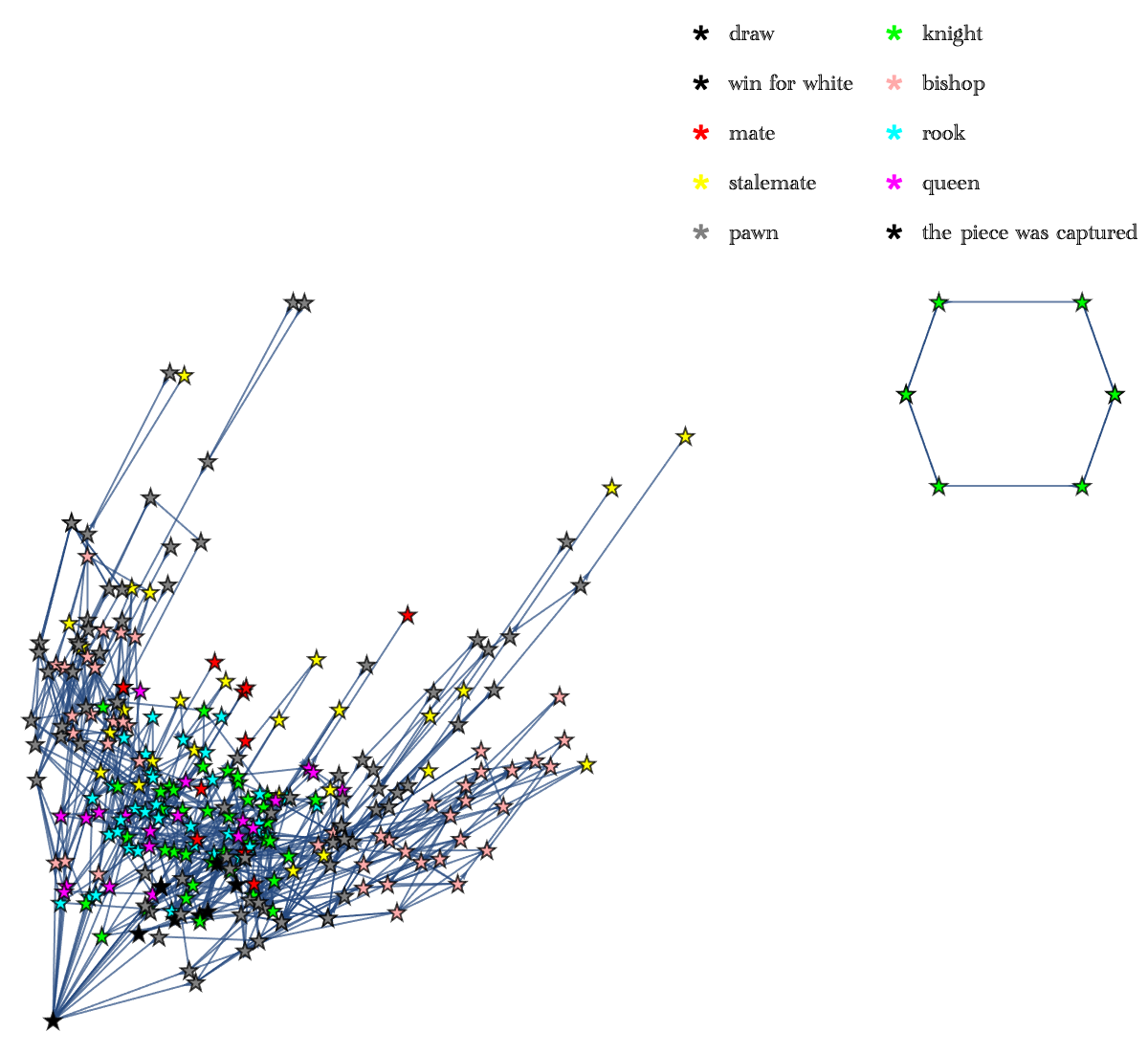showPieceGraph[n_, pieceName_] :=
Module[{positions, edges, vertexStyle, vertexLabels, vertexShapes,
legend},
positions =
DeleteCases[generatePositions[n],
p_ /; p[[5]] != pieceName && p[[5]] != "none"];
edges =
DeleteCases[
generateEdges[positions, n], (_ -> p_) /;
p[[5]] != pieceName && p[[5]] != "none"];
vertexStyle = generateVertexStyle[positions, n];
vertexLabels = generateLabels[positions, n];
vertexShapes =
Normal[KeySelect[
evaluationOfPositions[
n], #[[5]] == pieceName || #[[5]] == "none" &]];
vertexShapes =
vertexShapes /. {(a_ -> "win") -> (a -> "Square"), (a_ ->
"draw") -> (a -> "Circle")};
legend = PointLegend[
{Black, Black, Red, Yellow,
Switch[pieceName, "pawn", Gray, "knight", Green, "bishop",
Lighter[Pink], "rook", Cyan, "queen", Magenta], Black}, {"draw",
"win for white", "mate", "stalemate", pieceName,
"the piece was captured"}
];
Legended[
Graph[
edges,
EdgeShapeFunction -> ({Arrowheads[{{.01, .1}}], Arrow[#1]} &),
VertexStyle -> vertexStyle,
VertexLabels -> vertexLabels,
GraphLayout -> "SpectralEmbedding",
ImageSize -> 100*Sqrt@Length[positions],
VertexShapeFunction -> vertexShapes],
legend]]
The flexible, layered structure..@Pavel Arkhipov thank you for doing this you really saved us.
pieces = {"pawn", "knight", "bishop", "rook", "queen"};
Table[showPieceGraph[3, pieces[[i]]], {i, Length[pieces]}]
How do the natural language processing rules apply here; like let's say the rules might conflate a car, a piece, with a dog (a foliation position) because they have similar macro behavior?

generateGraph[n_] := Module[
{positions, edges},
positions = generatePositions[n];
edges = generateEdges[positions, n];
Graph[edges,
EdgeShapeFunction -> ({Arrowheads[{{.01, .1}}], Arrow[#1]} &),
VertexStyle -> generateVertexStyle[positions, n],
VertexLabels -> generateLabels[positions, n],
VertexShapeFunction -> "Star",
GraphLayout -> "HighDimensionalEmbedding",
ImageSize -> 600]]
showGraph[n_] := Legended[
generateGraph[n],
Placed[
SwatchLegend[
{Black, Black, Red, Yellow, Gray, Green, Lighter[Pink], Cyan,
Magenta, Black}, {"draw", "win for white", "mate", "stalemate",
"pawn", "knight", "bishop", "rook", "queen",
"the piece was captured"},
LegendMarkers -> {{"\[Star]", 20}, {"\[Star]", 20}, {"\[Star]",
20}, {"\[Star]", 20}, {"\[Star]", 20}, {"\[Star]",
20}, {"\[Star]", 20}, {"\[Star]", 20}, {"\[Star]",
20}, {"\[Star]", 20}},
LabelStyle -> {FontFamily -> "Academy Engraved LET",
FontSize -> 12, FontColor -> "Olive"},
LegendLayout -> {"Column", 2}
],
{Right, Top}
]
]
This project is so reasonable. No matter how you put it whether you're doing some far-fetched graph like the pawn graph or the rook, these are the atomic interactions which make mathematics & physics, as we traditionally know them, possible.
showGraph[3]

Our quantum reward! This is why @Pavel Arkhipov we've got experimental mathematics.